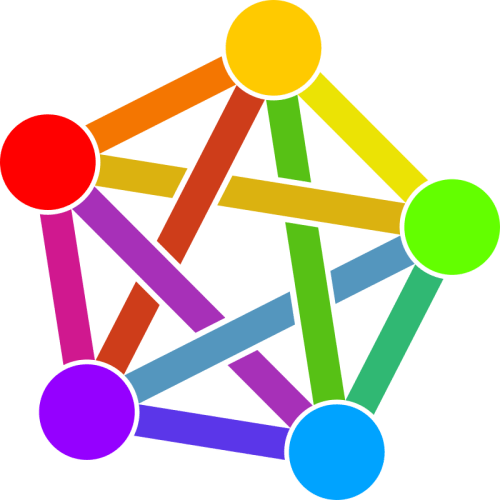
A Simple Guide to Mastodon (And the Fediverse)
Written for humans by a human. Lots of pictures!
I’m a fan of Mastodon. I like that I control what it shows me. I like that it doesn’t demand my time, or manipulate my attention with subliminal trickery. But what I like most is that it provides a way for people to easily connect online without corporate middlemen siphoning pennies off of everyone’s sanity.
Mastodon (and the tech that powers it) holds a lot of promise for news orgs, governments, and artists to “get the word out” in a way that’s widely accessible, yet free of divisive, engagement-obsessed algorithms. I dream of a world where I can easily follow friends, creators, and government agencies all in one place, without Elon, Zuck, Spez (or any other four-letter names) having a say in when or how. But before Mastodon can transform the world, it needs a critical mass of users! A lot of my readers have asked for an explainer on how it all works. So here it is as best I can do.
A (way shorter) just-tell-me-how-to-do-it guide is here if that’s more your speed:
What is Mastodon?
The simple answer:
Mastodon is a social media network created in the style of Twitter, but without ads or toxicity-inducing algorithms. It is community (not corporate) owned and operated.
A more detailed answer:
Mastodon is free (as in libre) software that runs on websites. It is created in a style similar to Twitter; it has profiles, posts, replies, and “boosts” (re-tweets).
There is only one Twitter, but there are many websites that run Mastodon. A website running Mastodon is called a Mastodon “instance”. They all look basically the same. Anyone with a lil’ know-how can make an instance pretty easily and allow their friends to join. Starting an instance is like having your own mini-Twitter. But the thing that makes Mastodon exciting is that all the (ten thousand+) instances out there are interoperable, so a user joining any one has access to follow, like, re-tweet, etc, with anyone on any Mastodon website.
Why You Should Care:
The simple reason:
Unlike Twitter (or Meta, or any social media company), Mastodon is not incentivized for addictive “engagement”. It is incentivized for conversation. Users have full control over the content they see, and how they see it. There are no mysterious algorithms pushing people towards well, anything they don’t want to be pushed towards.
A more detailed reason:
When a for-profit corporation is facilitating a conversation, the conversation itself —its quality, depth, reliability, even its factuality— will never be their priority. Profits are the priority. Profits are generated mostly in two ways: selling ads, and selling user data. This means (despite what is commonly said) their priority is not “connecting people” but holding their users’ attention as long as they conceivably can1.
These incentives simply do not exist on Mastodon. “Mastodon” is a tool, not a product. Nobody owns the software, and the people operating Mastodon platforms aren’t making big bucks (most sites are paid for by the owners out of pocket, or supported via small donations by users). The people starting an instance usually do it because they want to facilitate some kind of conversation.
Mastodon admins are incentivized to keep the platforms online, reliable, and free from intrusions such as spam and trolls. “Engagement” is only a priority when it’s meaningful. And what “meaningful” is up to the instance Admin and its users.
Do I Need Mastodon?
The simple answer:
Nope! And if you only want to follow people, you don’t even need an account. It’s an open platform so any profile can be easily followed using an RSS reader.
But if you do switch over and post, it’s more likely your social media-addicted friends will too. And the more people who switch, the more institutions you’ll see coming over too. And once the people and institutions are on board, society won’t have any need for corporate conversation-brokers like Twitter or Meta.
A more detailed answer:
If we want digital society to move away from big corporate platforms, and onto nonprofit community-owned ones, those of us who have the means and understanding to help should strongly consider getting the ball rolling on the change we wish to see. Heck- that logic is why I started this newsletter. Free, decentralized, community-owned things don’t usually have an advertising budget. Trust me there’s little money in getting the word out about things that don’t make money (plssubscribeiloveyou🙏)!
But as I’m always saying: technology should supplement our lives, not supplant it. In the event of cabin depressurization, we need to put on our own O2 masks before helping those around us. Just because Mastodon isn’t purposefully engineered to be addictive and distracting, doesn’t mean it can’t happen if you’re not careful how you configure it. If you’re someone who struggles with regulating yourself, don’t feel pressured to sign up. Keep on touching that grass.
How do I sign up for Mastodon?
The simple answer:
Download the Mastodon app (Apple store or Play store).
Create an account. Just like Twitter (or any other social media).
Follow people, and get posting.
A more detailed answer:
To make sign-ups simple, the official app defaults to Mastodon.social, the largest server (also run by the Mastodon developers). But you are also welcome to find an instance that resonates with you and create your account there. Are you mostly interested in being around other artists? Maybe sign up on mastodon.art. Are you a New Yorker? Check out masto.nyc. A journalist? Journa.host is created with you in mind.
This is a neat tool created to help people choose an instance. But I really can’t stress this enough: don’t overthink choosing an instance. They all provide access to the same network and all function largely the same. And if you choose one and decide to switch later it’s entirely possible to move without losing your followers or the people you’re following.
That’s it?
The simple answer:
That’s it.
A more detailed answer:
That’s really all you need to know to get going. Don’t forget to smash that like button y’all and blast this to your friends on for-profit social media. ✌️😎
Other Questions you may have:
Who owns Mastodon?
The simple answer:
Nobody.
A more detailed answer:
Nobody owns the Mastodon network. Nobody owns the Mastodon software. The software is maintained by a nonprofit based in Germany headed by Eugen Rochko. That nonprofit is funded largely by donations. Eugen is not a billionaire. But even if he was, he couldn’t own Mastodon.
People do own the actual websites (“instances”) running Mastodon. Some are big, and some are small, many are only one person. That German nonprofit I mentioned also owns and operates Mastodon.social, the largest instance, and the default option in the app.
What about “Federation”? And what is “The Fediverse”?
The simple answer:
“Federation” is how Mastodon can function without anyone owning the whole network. “The Fediverse” is the informal name given to all connected sites.
It’s not really important to know this in order to use Mastodon. Nerds think it’s cool, but if you’re on the official app it doesn’t really matter.
A more detailed answer:
“Federation” means that users can interact with (reply, favorite, re-tweet, etc) any other Mastodon user no matter the instance. It’s like if Threads users could reply to Twitter users and vice versa. “The Fediverse” refers to this big interconnected web of instances that are able to interact.
Even if say- an emotionally insecure billionaire were to hypothetically buy up every single instance, the Mastodon software can’t be bought, so it would be trivial for new people to create and connect thousands of new instances outside of the billionaire’s control.
The concept of federation is a little confusing, and it’s where many people get hung up on Mastodon. But I think it’s only confusing because we’ve only ever had large, centralized platforms that don’t interact. It’s like trying to explain the concept of a “neighborhood” to someone who grew up only going to Wal-Mart.
“You mean the ‘bakery’ store only sells bread? And it’s a different owner than the Pet store? But I can use my same bank card at both??🤔🤔🤔”
Think about it like email. Nobody owns “email”. Gmail users can message Hotmail users easily, but you can’t use your Twitter account to post to Threads.
Federation works because of a protocol called “ActivityPub”. There are other apps (like Lemmy or PixelFed) that use ActivityPub too. “The Fediverse” usually refers to all sites using ActivityPub. Not just Mastodon.
So what’s Defederation?
The simple answer:
“Defederation” is when one instance blocks another instance entirely.
A more detailed answer:
Defederation is a tool for instance owners to prevent bad actors from interrupting and derailing conversation on their instance. For example: imagine an instance that for whatever reason, doesn’t remove spam accounts. By “defederating”, other instance owners can protect their users from spam accounts hosted elsewhere.
Some instances rarely defederate from others, if ever. Some do it more often. For example LGBT and other marginalized communities tend to use it to prevent outside harassment on their instances. Everyone using Mastodon users have freedom of speech, but nobody has freedom to be listened to.
How do I follow users who are on another instance?
The simple answer:
If you’re using the app, just click “follow” on their profile.
A more detailed answer:
When using a browser, most of the time you can just search from your Mastodon site and find them. But it’s harder to link directly, because each instance is functionally its own website. If you’re like me and mostly check Mastodon in a web browser, this Firefox extension (Chrome version) makes it as easy to follow as it is on mobile.
What’s this about Lemmy and Pixelfed?
The simple answer:
Just as Mastodon is made in the style of Twitter, Lemmy is made in the style of Reddit, and Pixelfed is made in the style of Instagram. They are all open-source, meaning like Mastodon, nobody owns them either.
A more detailed answer:
The underlying protocol for Mastodon, Lemmy, Pixelfed (and others) is called ActivityPub. Nobody owns ActivityPub. Anyone can set up a Lemmy instance and interact with other Lemmy instances, like if each Reddit subreddit was independent from each other.
Technically speaking, two sites don’t even need to be using the same software to be interoperable. You can post to Lemmy from Mastodon (and vice-versa) since they both use ActivityPub. That said- doing that can get confusing fast and isn’t really recommended. But it’s possible because the “language” is the same. Mastodon is the most “mature” and the most used Fediverse app by far, but the others are growing.
What if I’m worried about Privacy?
The simple answer:
Well, get the heck offa Twitter, Reddit and all Meta products, for starters. Assume everything you post anywhere is public. Mastodon is still on the internet, after all.
A more detailed answer:
As far as tracking users’ every move, Mastodon does not do it by design. Without ads to sell, there is little need track behavior.
You should not sign up to a site you don’t reasonably trust the owner. But also the chances of any random Instance owner having fewer moral scruples than Elon, Zuck, Dorsey or Spez is well, improbable.
That said, if don’t trust anyone- it’s not complicated to run your own instance for as cheap as $5/month.
How is the Fediverse for Content Creators?
The simple answer:
Mastodon, Lemmy, and Pixelfed do not have rigged algorithms deciding who gets noticed and who doesn’t. And as it stands now, the network isn’t as big as the commercial platforms. This limits reach, but can also help emerging artists be noticed by standing out.

A more detailed answer:
It’s not easy out there for creators. Commercial platforms have larger reach, but only if creators are willing to cater to the desires of the algorithm. This causes creators to compromise their visions in order to be noticed at all. There’s nothing wrong with promoting oneself on commercial social media, but it needs to be done carefully. For more on this topic, see the following post:
Corey Doctorow’s now-famous piece on Enshittification includes this line about carnival games as a metaphor for how Social Media companies treat creators:
The peach-basket is a rigged game. The carny can use a hidden switch to force the balls to bounce out of the basket. No one wins a giant teddy bear unless the carny wants them to win it. Why did the carny let the sucker win the giant teddy bear? So that he'd carry it around all day, convincing other suckers to put down five bucks for their chance to win one.
Corporate Social Media offers creatives the hopeful illusion of a chance at virality, but it only gives virality to those willing to produce the sorts of shallow content that keeps other users hooked on the platform. It feels random, but it’s carefully engineered to keep creators constantly guessing.
Fediverse apps like Mastodon are still a middleman between creators and their audiences, but they do what middlemen should do: facilitate connections, not disrupt them.
Thanks for reading, hope this helps you! My account is here if you’d like to connect!
If you have any other questions, feel free to leave a comment or reply to the email and I’ll do my best to answer it!
(If you’re unsure of why that’s a problem, I happily direct you to the entirety of StayGrounded.online).
















